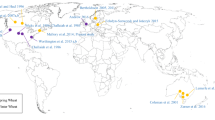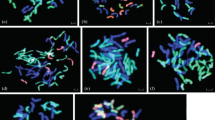Abstract
The heritability of tolerance of wheat F3 lines to competition from annual ryegrass (Lolium rigidum), and its relationship to morphological traits, were determined using crosses between wheat cultivars with good and poor competitive ability. Forty F2-derived F3 lines from a cross between two late flowering varieties (Machete × Spear) and 40 from a cross between early flowering varieties (Wilgoyne × Gutha) were grown in the field with and without annual ryegrass. There was significant genetic variation between lines within each of the two populations in a number of aspects of plant growth and development, including yield in monoculture. The estimates of heritability for % yield loss due to competition were 0.25 and 0.57 in the two crosses respectively, indicating that selection for high tolerance to competition in the F3 generation or later should be effective. Fairly strong relationships between height and % yield loss and between leaf length and % yield loss suggest that these may be useful auxiliary traits when selecting for low % yield loss. However, differences between crosses in the magnitude and sign of genetic and phenotypic correlation between traits indicate that competitive ability is a complex character influenced by many factors.
Similar content being viewed by others
Author information
Authors and Affiliations
Rights and permissions
About this article
Cite this article
Mokhtari, S., Galwey, N., Cousens, R. et al. The genetic basis of variation among wheat F3 lines in tolerance to competition by ryegrass (Lolium rigidum). Euphytica 124, 355–364 (2002). https://doi.org/10.1023/A:1015752021568
Issue Date:
DOI: https://doi.org/10.1023/A:1015752021568




